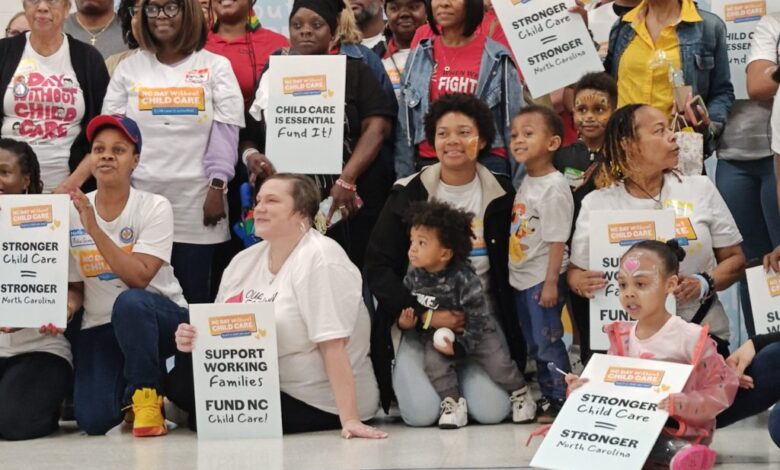Child care advocates in NC look for ways to survive after loss of federal pandemic aid


By Jennifer Fernandez
CHARLOTTE — The Queen City has evolved over the years, and industries have followed suit — growing and improving.
Except for the child care industry, Laterria Lassiter told a crowd of about 85 people at the Pathway Preschool Center on Monday for a “NC Day Without Childcare” demonstration.
“The early childhood industry has continued to be stagnant,” said Lassiter, a parent, advocate and former child care center owner.
Pay remains so low that child care workers, who make about $14/hour, can go to Target or McDonald’s and make more money, state data shows. State subsidies to help low-income families afford child care aren’t enough to cover the actual cost, other advocates have said.
Yet, child care is essential to the community.
“When child care disappears, even for a day, we know everything stops,” said Sharon James, a field organizer with the National Domestic Workers Alliance, which helped organize Monday’s rally. “Parents can’t work. Businesses struggle, and children lose care and education they need.”

Organizers said more than 100 child care providers shut down working on Monday to attend rallies in Charlotte and Raleigh. About 95 people attended the Raleigh event, also held indoors due to rain.
At the rallies, advocates argued for more support from state lawmakers, including $220 million to improve child care subsidies and $60 million to help child care workers afford sending their own children to child care.
“We are in the midst of a crisis, one that affects our economy, our workforce and most importantly, our children,” said Brenda Campbell, a family home provider and community leader with Westside Network Providers in Charlotte. “Our hard-working families face waiting lists, high costs and the agonizing choice between earning a living and securing safe quality child care.”
Cost of care
Dwayne Streater, pastor at Breakthrough Worship Center in Charlotte, said he came to Monday’s rally to support the cause. He also provided opening and closing prayers for the event. His son attends daycare at Pathway Preschool Center.
“You want the care of your children in the hands of the best,” he said, but added that’s hard to do when the pay doesn’t support hiring the best people.
Child care is also costly for parents. Last year, North Carolina parents paid on average $22,751 to have an infant and 4-year-old in a child care center, according to Child Care Aware, a national nonprofit that supports all aspects of the child care system. Care in a family-based program cost about $19,000. In comparison, the average cost of in-state tuition and fees at a university in the UNC System in 2024 was about $6,500 a year.
Matt Martin, whose 2-year-old daughter, Eveyln, attends Pathway Preschool Center, said his family pays 15 percent of their take-home income on child care.
“Speaking from the stance of somebody who can afford that, that’s just too high,” he said. “It’s insanely high, and it’s unaffordable for many other families, and I know that I hear that from other people all the time.”
Campbell said the cost of child care can’t fall just on parents, providers or even the government. Businesses are a crucial part of the equation and need to take part in the solution, she said.
Support for the child care industry means expanding funding for affordable child care programs and providing more support for subsidies and grants that can bring relief to struggling families and allow daycare providers to offer quality service, she said. It also means offering accessible child care options, which means cutting red tape, exploring innovative forms of child care and updating licensing, among other changes, Campbell said. And the low pay for child care workers must be addressed, she said.
“They deserve compensation that reflects the vital work they do for our children and our community,” Campbell said.
She encouraged companies to get involved. They can help by establishing employer-sponsored child care programs, providing on-site care and exploring public-private partnerships, she suggested.
“Let’s solve our daycare crisis together,” Campbell said.
Funding woes
During the COVID-19 pandemic, the federal government pumped money into child care nationwide to keep centers afloat. As many people shifted to work from home and schools switched to remote learning, children also stayed at home. Enrollment dropped at child care centers, cutting into their income. But they needed to stay open to care for children of workers, such as health care and law enforcement, who couldn’t do their jobs from home.
As the pandemic waned, that funding dried up. North Carolina child care advocates warned that sites would have to hike prices and that many would close. Earlier this year, EducationNC reported a net loss of 5.6 percent of licensed programs from just before the pandemic to November 2024.
North Carolina lawmakers passed two rounds of funding to keep the centers stabilized, but those grants ran out at the end of March. They’ve since turned their attention to legislation that lawmakers say would reform the industry and make it more sustainable by flexing staffing and capacity regulations to make it easier for child care providers to operate and expand.
Organizers of Monday’s rally said they knew the state funding was a temporary fix.
Now they are looking to make systemic changes and find permanent solutions, but that also requires financial support.
This time, they’re asking state lawmakers for $220 million to establish a statewide floor for the child care subsidy reimbursement rate.That would establish a minimum amount that programs would receive for serving children through the state’s subsidy program, which helps eligible low-income families pay for child care so parents can go to work. Currently, those rates vary widely among counties.
Creating a statewide floor for the subsidy rate would help get providers closer to the actual cost of care, organizers argued Monday. It also would help keep programs open and improve staff pay, they said.
The Senate’s budget plan, passed April 16, included $80 million to increase child care subsidy rates — much less than what advocates say is needed.
Their second request is for $60 million to help child care workers pay for their own children to be in child care.





Speaking out
Speakers on Monday said it is vital to keep child care in the spotlight as state and federal lawmakers work on their budgets for next year.
President Donald Trump’s administration has already made cuts to several programs that help families and child care workers. Medicaid is also being eyed for changes that would lead 8.6 million people to lose coverage, according to media reports. Not only would that affect parents struggling to pay for child care, it also would hurt child care workers who often qualify for the health care program.
“The crisis that we’re in is dire, and we do want to take some action,” James said, encouraging participants to call on their legislators to support child care.
Devonya Govan-Hunt, president of the Black Child Development Institute Carolinas, said she is tired of people saying there’s not enough money to make sure everybody has child care or to pay providers what they’re worth.
They’re making a decision to say child care is not that important, she said.
“North Carolina has plenty of money,” she said. “These decision makers decided to collectively not support … the places that the people have said matters the most. That is our children, our families and our communities.”
State and federal governments have the money, said Jennifer Wells, director of economic justice with Community Change/Action, which launched the “A Day Without Child Care” rallies nationally in 2021.
“They just need to be forced to place it in the right pot,” she said.
The post Child care advocates in NC look for ways to survive after loss of federal pandemic aid appeared first on North Carolina Health News.
